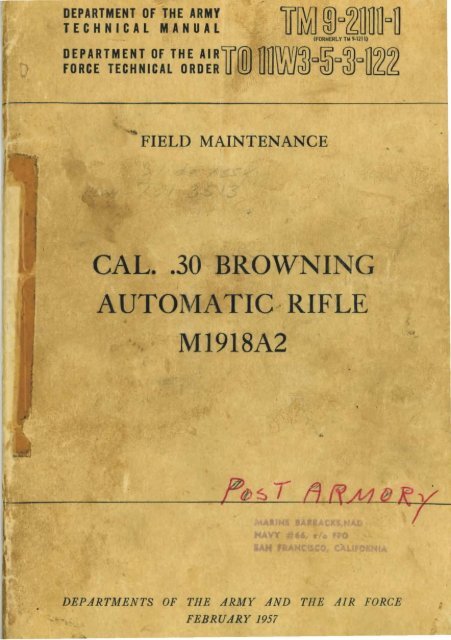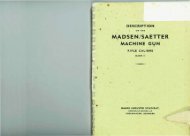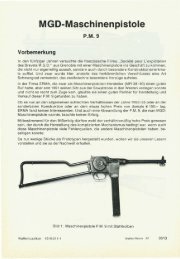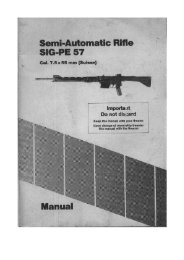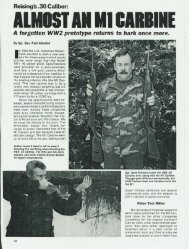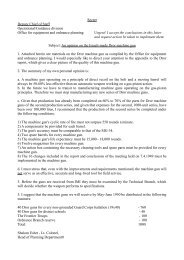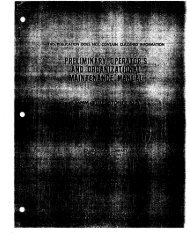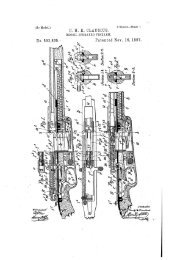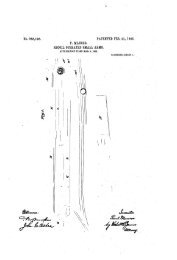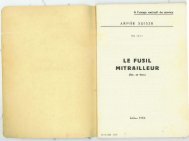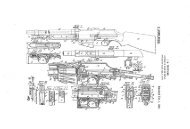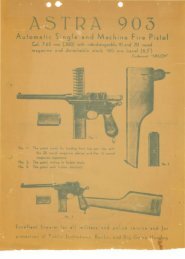1918a2 bar manual.pdf - Forgotten Weapons
1918a2 bar manual.pdf - Forgotten Weapons
1918a2 bar manual.pdf - Forgotten Weapons
You also want an ePaper? Increase the reach of your titles
YUMPU automatically turns print PDFs into web optimized ePapers that Google loves.
d. Inspeet locking action of bolt lock and bolt.<br />
e. Fire several rounds of service ammLmition, and examine primers of<br />
fired casings. If primer shows indications of being set back in firing pin<br />
hole of bolt, due to an enlarged fi ring pin hole or re essive weat· of bolt<br />
face, replace the bolt.<br />
Warning: Test-fire when and where conditions permit, considering<br />
safety and expediency.<br />
16. SIGHTS<br />
a. Check front sight base for looseness on the <strong>bar</strong>rel, and check blade<br />
for looseness in the base.<br />
b. Blade must be straight and top of the blade square and properly<br />
darkened.<br />
c. In ·pect rear sight base for looseness on receiver.<br />
d. Inspect windage scale for looseness on base.<br />
e. Check spring for functioning.<br />
f. Inspect fun ctioning of elevating :>crew and leaf with slide. Both<br />
must operate freely and retain setting.<br />
g. Windage knob will turn freely by hanrl and retain set. An acceptable<br />
dull finish is required on all parts.<br />
17. Bipod Group<br />
a. Inspect bipod assembly for proper fit on flash hider bearing.<br />
b. Inspect bipod assembly for looseness on <strong>bar</strong>rel.<br />
c. Inspect for missing or broken friction washer and sight cover.<br />
d. Sliding legs will move readily to any position and wil l be locked and<br />
held by the bipod leg thumbscrews.<br />
18. Barrel and Receiver Group<br />
Note. Weapon must be field-stripped (FM 23-15) to perform pertinent gage<br />
checks.<br />
a. Inspect headspace as described in paragraph 27.<br />
b. Check breech bore dimension, using breech bore gage 556-±3-±3<br />
(fig . 3). Insert the gage into the chamber. Looking through the ejection<br />
port and using the calibrated scale of the gage, read indication that<br />
appears just flush 'i\rith the rear face of the <strong>bar</strong>rel. It should be 0.3 10<br />
in ch or less.<br />
c. Inspect receiver for wear, burs, rust, and foreign matter.<br />
d. Inspect for loose bolt supports.<br />
e. Inspect bolt lock recess in top of receiver. Check especiall y where<br />
lock seats when bolt is locked . Burs here will affect headspace.<br />
f . Inspect operating handle for functioning and free movement in<br />
slideways. Inspect plunger for free movement and spring tension.<br />
g. Top plate should not be loose and a drive fit is required.<br />
14<br />
AGO 4471B<br />
19. Bolt Group<br />
a. Inspect firing pin hole for out-of-round.<br />
b. Check firing pin protrusion. It should be approximately three<br />
thirty-seconds inch.<br />
c. Check firing pin for broken point, wear, bms, and fracture.<br />
d. Remove extractor. Check spring for set or fracture, and check lips<br />
of extractor for wear.<br />
e. Check bolt link and lock for excessive wear, burs, and galling.<br />
Check holes for out-of-row1d.<br />
20. Slide and Piston Group<br />
a. Check fit between piston and slide.<br />
b. Total endplay of piston should approximate one-eighth inch in any<br />
direction and face of piston must not strike gas cylinder body when slide<br />
is in fully forward position. Gage piston, using NO GO gage 5077201<br />
(fig. 3). Piston head should not enter gage. To gage, first clean piston<br />
thoroughly of all carbon and fouling, and determine that surfaces of head<br />
ring are smooth and polished. Wipe piston head and gage with a slightly<br />
oiled doth and try to pass gage over piston head. (Only light pressure<br />
should be exerted on gage.)<br />
c. Inspect slide for burs, deformation, galling, or battered rear end.<br />
d. Check hammer pin hole for out-of-round.<br />
21. Trigger Guard Assembly<br />
a. Check functioning by hand operation.<br />
b. Check change lever for movement in a ll po:;ition. · aucl ability to retain<br />
setting.<br />
c. 'heck ejector for bw·s fracture, or clefonnat,iou.<br />
ct. Check all springs for tension and set.<br />
e. Check magazine release and catch for proper furtctioning.<br />
22. Buffer and Actuator Group<br />
a. Check actuator for free movement in actuator tube.<br />
b. Check actuator spring for kinks, rust, and free length.<br />
c. Check buffer head assembly for burs, missing key, and sear release<br />
for free movement and correct assembly. Check cones and cups for set<br />
and proper assembly .<br />
23. Gas Cylinder Group<br />
a. Inspect gas cylinder for dents, cracks, deformat ion, and distortion.<br />
b. Check gas port in the gas cylinder body to be sw·e it is free of carbon<br />
or other foreign matter.<br />
c. Check gas cylinder body for burred or· stripped threads.<br />
AGO 4471B 15
Table II. T1·oubleshooting-continued<br />
Malfunction Probable cause<br />
Failure to eject ________ __ JJirLy or clogged ga ports_<br />
Failure to extract ___ ____ _<br />
Failme to pull off with<br />
change lever set at For<br />
A. Muzzle depre sed.<br />
20<br />
Broken ejector _____ ____ _<br />
Weak or broken ejector<br />
lo k and/ or ejector<br />
lock pring.<br />
Damaged or broken extractor<br />
claw.<br />
Broken or missing extractor<br />
pring.<br />
Sear pring not correctly<br />
positioned.<br />
Corrective aclion<br />
Clean and properly adjust<br />
ga cylinder assembly<br />
(pars. 67 a nd 70).<br />
Replace ejector (pars. 4
(3) omplete disassembly of a w1it is not always necessary in order<br />
to make a required repair or replacement. Good judgment<br />
·bould be exercised to keep el i. assembly operations to a min imum.<br />
b. Replacement of Parts.<br />
( I) Un erviceable and unrepairable as. emblie will be broken down<br />
into items of issue and serviceable parts wi ll be returned to<br />
stock. Parts or a semblie Lhat cannoL be repaired or reclaimed<br />
to the .tandards et forth in thi. publication will be replaced<br />
as indicated.<br />
(2) \\
e. Correcting Trigger Pull.<br />
(1) uight t1·igger pull. Light trigger pull is caused by foreign matter<br />
or burs in sear notch of slide or nose of ear. Such burs or·<br />
foreign matter prevent nose of sear from seating fully in sear<br />
notch in slide. To correct, remove foreign matter or stone<br />
burred surfaces as m.rplained in d above. Replace badly burred<br />
or damaged parts. A light pull is also due to a weak or broken<br />
sear spring that does not seat the sear fully in the notch in<br />
slide; correct by replacing sear spring.<br />
(2) Excessive trigger pull. Excessive trigger pull is caused by binding<br />
on components of trigger group foreign matter in trigger<br />
guard body, or bw-s on trigger, connector, sear pin, or sear;<br />
correct by removing foreign matter and stoning bw-red surfaces.<br />
f. Fitting New Trigger Gum·d. In fitting new trigger guard to receiver,<br />
it may be found that trigger guard retaining pin holes in trigger guard<br />
body and receiver are not concentric. In such event, stone off rear<br />
beveled surface of trigger guard or mating lug on receiver slightly to<br />
aline holes. Use fine-grained sharpening stone.<br />
g. Jl!I odifying Sea1· Spring. File row1ded notch in sear spring with<br />
small rattail (Swiss pattern) file to the dimensions prescribed in figme 8.<br />
The notch facilitates removal and redu es breakage of sear spring.<br />
47. Assembly<br />
30<br />
Figure 8. Filing notch in senr sp1·ing.<br />
//<br />
3/64 /<br />
RAD\ ,<br />
II I<br />
Refer to Fl\11 23- 15 for assembly of the trigger guard assembly (fig. 6).<br />
AGO 4471B<br />
48. Functional Check<br />
a. Inspect trigger guard a:. embly for looseness, fw1ctioning, and cofunctioning<br />
of its a semblies and parts. Trigger guard assembly assembles<br />
freely to receiver without apparent looseness or sideplay.<br />
b. Check function of trigger, cmmector, and sear spring with trigger<br />
guard assembly held horizontal, tipped forward, and tipped back. If<br />
sear spring is not bearing properly on forward shoulders of sear and<br />
center prong on connector, the connector will not ftmction properly<br />
when trigger guard assembly is tipped. Check functioning of trigger,<br />
ear, and stop lever, when change lever is set at A position (normal cyclic<br />
rate), F po.-ition (slow cyclic rate), and S position (safe) (fig. 9).<br />
RAPD 910448<br />
fi'igw·e 9. Various posilio11s of change lever on assembled trigger guard assembly.<br />
(1) hange lever set at A (vertical position) (fig. 9). When change<br />
lever i set at A position and tl·igger is retracted, the connector<br />
rai ·es the for\Ya.rd end of sear and sear release stop lever together<br />
and holds them up as long as trigger is held fu lly retracted.<br />
Thus the rear end of the sear is depressed and held<br />
from engagement with sear notch in slide, while the rear end of<br />
sear release stop lever is also depressed, preventing sear release<br />
from striking caroming smface on rear end of sear. When<br />
trigger is released, sear and sear release stop lever both return<br />
to their normal positions.<br />
(2) Change lever set at fi' (fonuaTd position) (fig. 9). When change<br />
lever is set at F po ition and trigger partially retracted, the<br />
connector raises the fonYard end of sear and sear relea e stop<br />
lever together. As trigger is further retracted, the connector,<br />
still rising, is caromed from under front of sear by camming<br />
surface on sear carrier, and continues to raise forward end of<br />
sear release stop lever, and holds it in rai. eel position as long as<br />
AGO 4471B 31
(5) Buffer tube is threaded into receiver and is never removed except<br />
for replacement or repair. To remove, clamp receiver in<br />
vise with leather jaws, first inserting buffer tube alinement tool·<br />
spacer 7113328 (fig. 4) inside faces of receiver walls to prevent<br />
springing of the receiver, and then unscrew buffer tube with<br />
strap wrench (fig. 13).<br />
---STRAP WRENCH<br />
BUFFER TUBE All NEMENT<br />
TOOL SPACER-7113328<br />
Fig ure 18. Removing btt:ffer tube.<br />
RA PD 91399C<br />
(6) If necessary, remove top plate of receiver by driving out of<br />
grooves to front of receiver, using a block of hardwood as shown<br />
in figure 14.<br />
51. Inspection<br />
a. Ban·el.<br />
(1) General inspection. Inspec <strong>bar</strong>rel for deformation, alinement in<br />
receiver, crossed threads, rust, corrosion, wear, burs, and foreign<br />
matter in gas port and extractor aperture. Barrel must<br />
aline exactly with receiver 'vhen assembled, in order that rear<br />
end of gas cylinder tube will fit mating slot in receiver; front<br />
sight will aline properly; and extractor aperture will be correctly<br />
positioned, drilled, and pinned during manufacture of the rifle<br />
after <strong>bar</strong>rel is assembled to receiver. A draw mark is then<br />
placed in <strong>bar</strong>rel and receiver for proper alinement upon assembly.<br />
If draw marks do not qualify, fashion a shim from<br />
shim metal.<br />
36<br />
AGO 4471B<br />
I<br />
AGO 4471B<br />
37
manufactme cannot be rotated to be withdrawn from receiver; however,<br />
pin 5022232 of latest manufactme has a screwdriver slot on end for removal<br />
of pin when spring breaks.<br />
52. Repair<br />
a. General. Replace all broken, worn, or otherwise unserviceable parts.<br />
Remove burs and r ust as explained in paragraphs 35 and 36.<br />
b. Replacing Unserviceable Barrel.<br />
(1) Disassemble <strong>bar</strong>rel from receiver (par. 50).<br />
(2) Assemble new <strong>bar</strong>rel assembly, which includes front sight base<br />
and gas cylinder tube bracket. Screw up <strong>bar</strong>rel until draw<br />
marks on <strong>bar</strong>rel and receiver register. Assemble gas cylinder<br />
tube to bracket; then check fit and alinement of rear tang and<br />
retaining pin holes in tang and receiver. If tang of tube does<br />
not mate without binding, turn <strong>bar</strong>rel until this is accompli bed.<br />
Barrel ·hould draw up tightly to receiver so there is no possibility<br />
of vibrating loose. If there is no draw mark on <strong>bar</strong>rel,<br />
draw up until tube alines as above and check position of extractor<br />
cut by assembling bolt with extractor assembled.<br />
(3) If <strong>bar</strong>rel does not draw up to proper position, ch·ess rear face of<br />
shoulder in a lathe.<br />
(4) Never alter the receiver to obtain draw-fit. When <strong>bar</strong>rel is<br />
alined, check alinement of gas cylinder tube, front sight, and<br />
extractor cut. If <strong>bar</strong>rel requires much shimming or dressing<br />
to aline, headspace may be affected.<br />
c. Front Sight Blade Out of Alinement. This is usually due to enlarged<br />
dovetailed aperture in base. Peen lightly along upper edges aline sight<br />
blade (by eye), and stake, using old stake mark. Base pin may be missing;<br />
if so, replace and aline blade.<br />
d. Rough or Wavy Swface of Bolt Locking Recess in Receiver. If surface<br />
of bolt locking rece s in receiver is bmred or wavy, correct by removing ·<br />
top plate (par. 50c(6)) and -toning rough or wavy surface smooth with a<br />
fu1e-grained sharpening stone Exercise care to stone evenly and remove<br />
as little metal as possible, as this surface affects headspace. Check<br />
headspace (par. 27) after stoning.<br />
e. Loose Spring on Gas Cyl-inder Tube Retaining Pin. If spring becomes<br />
loose hom body of pin, it may be impossible to withdraw pin by ordinary<br />
methods for replacement. In such event, attempt to revolve and shake<br />
pin out of aperture or pull out with needle-nosed pliers.<br />
f. Dents in Bu.tfer Tube. Shallow dents in buffer tube are often removed<br />
by reaming with an expansion reamer et to the original inside<br />
diameter of tube. Larger dents may be swaged out, first by using rod<br />
the size of inside diameter of tube and then reaming. If dents are deep<br />
enough to cause possible weakening of wall of tube due to this procedure,<br />
replace the tube. Test components in tube after repair for free movement.<br />
40<br />
AGO 4471B<br />
53. Assembly and Installation<br />
a. A embly of Receiver Group (fig. 12).<br />
(1) Install top plate, being careful no to deform the dovetail.<br />
(2) Install buffer tube on receiver as sho\\'·n in figure 20, being sure<br />
that one of the eight groove in the head of the tube lie centrally<br />
horizontal with the top of the receiver with nose down.<br />
'lamp receiver in vise, first inserting the pacer 7113328 (fig. 4)<br />
of the buffer tube alinement tool 6316001 between inside faces<br />
or receiver walls to prevent queezing of receiver, and insert<br />
parallel 7113327 (fig. 4) of buffer tube alinement tool into receiver,<br />
\Yith keyed end toward buffer tube end of receiver a.<br />
shown in figure 16. 'tart the buffer tube into the ends of the<br />
receiver and inser plug 7113326 (fig. -±) of buffer tube alin ement<br />
tool as shom1 in figure 16. Tighten buffer tube with<br />
:trap \Yrench until plug engages keyed end of parallel.<br />
Note. BufJer tube mu t be at tightest possible position at which the<br />
plug and pamllel 1\i.ll engage, u ing shim or h.ims, if ne es ary.<br />
(3) In tall change lever stop pril1g assembly in re eiver and ecure<br />
with change lever stop pring retaining pin.<br />
(4) Insert the longer turned-over end of bolt guide pring in its hole<br />
inside the receiver. Then install the bolt guide and hold it<br />
while the spring is pushed over lmtil the horter t urned-over<br />
end engages the groove in bolt guide.<br />
(5) In tall operating handle plunger spring (0.263-in. 0 D, 5 coil )<br />
in the operating handle. Insert operating handle plunger and<br />
ecure with operating hanclle plunger pin. Be sme pin is installed<br />
with ridge in colmter unk side of plunger.<br />
(6) Inser operating handle group in Licleway on receiver.<br />
b. Assembly of Barrel Assembly (fig. 11).<br />
(1) Install gas cylinder tube bracket, being sure to aline gas port<br />
holes. Secure bracket in place \\ith gas cylinder tube bracket<br />
pin (0.1257 x 0.855).<br />
(2) Po ition front sight key in groove on <strong>bar</strong>rel and install front<br />
ight base. Secure them in place "·ith the fron ight key pin<br />
(0.0907 X 0.505).<br />
(3) Install front sight blade and realine ights.<br />
c. Installing Barrel Into Receiver (fig. 10). When installing the <strong>bar</strong>rel,<br />
always be certain that it is tight enough in the receiver never to work<br />
loose. Screw the <strong>bar</strong>rel into the receiver until he draw line matches<br />
that of the receiver. Then assemble the gas cylinder tube to determine<br />
whether the gas cylinder tube bracket on the banel alines properly with<br />
the receiver, so gas cylinder tube rear tang slides easily into its aperture<br />
in receiver. If it does not, turn the <strong>bar</strong>rel slightly until the alinement is<br />
correct. "'hen assembled, check extractor cut in rear face of <strong>bar</strong>rel for<br />
position. For assembling new <strong>bar</strong>rel, refer to paragraph 52.<br />
AGO 4471B 41
Section IV. BOLT GROUP<br />
54. Removal and Disassembly<br />
Refer to FNI 23-15 for rcmo\'al and disa cmbly of the bolt group<br />
(fig. 17).<br />
55. Inspection<br />
a. General. Inspect parts for damage, excessive \Year which might<br />
cause malfunction, burs, ru t, foreign matter in recesses, deformation,<br />
and free action with mating parts. Figure ] shows important points<br />
to be inspected.<br />
EXTRACTOR-5509090<br />
HAMMER-<br />
6019643<br />
Ji'iguTe 18.<br />
{SIDE YIEWJ<br />
BOLT -5509068<br />
FIRING PIN-6019652<br />
'I<br />
BOLT LOCK-5509072<br />
Inspection points on bolt group pa.Tls.<br />
(END YIEWl<br />
RA PD 917568<br />
b. Bolt (fig . 17). Inspect bolt for excessive sideplay and looseness with<br />
bolt lock and bolt lock pin (riveted). Inspect firing pin hole for enlargement,<br />
and inspect face for corrosion and recessive wear. Firing pin holes<br />
are gaged by fifth echelon organizations. Inspect lower smfaces contacting<br />
bolt supports and center feed rib for wear and burs.<br />
AGO 4471B<br />
c. Bolt Lock (fig. 18). I nspect rear top shoulder where lock contacts<br />
receiver locking aperture for wear and burs. This is an important surface,<br />
as it affects headspace (par. 27). Inspect lower rear cam surface<br />
where lock rides up on bolt supports and firing pin camming surface for<br />
wear and burs.<br />
d. ExtracloT (fig. 18). Inspect extractor spring for fracture, weak<br />
action, and looseness in extractor body. Claw nose and retaining<br />
shoulder are square, not beveled .<br />
e. Firing Pin (fig. 18). Firing pin should slide freely in well and protrusion<br />
of nose from forward face of bolt should be approximately three<br />
thirty-seconds inch. If firing pin protrudes too far, it will result in<br />
punctmed primers. Inspect firing pin nose for pits. Nose must be<br />
smooth and round. The camming surface contacted by the bolt lock<br />
and rear surface contacted by the hammer must be free of wear that<br />
would affect action of firing pin.<br />
f. Bolt Link and Bolt Link Pin (fig. 18). Inspect link for excessive<br />
looseness with bolt lock and hammer. When assembled, the link bears<br />
on rear camming face of bolt lock.<br />
g. Hammer and HammeT Pin (fig. 18). Inspect hammer for excessive<br />
looseness with link and slide. Inspect center rib of hammer \vhich strikes<br />
head of firing pin for wear and bms. Hammer pin must fit snugly in the<br />
hammer and bolt link.<br />
56. Repair<br />
a. General. Replace all broken, worn, or othenvise unserviceable parts.<br />
Remove burs and rust as explained in paragraphs 35 and 36.<br />
b. Bolt Assembly. If it is necessary to replace one of the parts of the<br />
bolt assembly, drive out the bolt lock pin, using a suitable drift. This is<br />
a headed pin riveted on one side when assembled. After replacing the<br />
unserviceable part , install a new pin and rivet in plaoe.<br />
57. Assembly and Installation<br />
R efer to FM 23-15 for assembly and installation of bolt group (fig. 17).<br />
58. Functional Check<br />
Check free movement of bolt, bolt lock, link, and hamm er attached to<br />
slide and piston, but with rer.oil spring disassembled.<br />
a. RearwaTd Movement. When bolt is locked, the hammer pin should<br />
be approximately 0.1 9 inch in advance of the linlc pin and the center rib<br />
of hammer slightly in the rear of head of firing pin. When slide is ret<br />
racted, it imparts no motion to t he bolt until it has traveled back 0.19<br />
inch from extreme forward position. At this point, the hammer pin<br />
should be directly under the bolt linlc pin. From t his point, the bolt<br />
and bolt lock start to move, and by the time the slide bas traveled 1.20<br />
inches, the bolt shou ld be drawn completely dmvn out of the locking re-
(2) Unscrew the short and long forearm screws, and remove the<br />
screws, the forearm screw washer, and the forearm from the gas<br />
cylinder t ube. The long forearm screw is staked to the escutcheon.<br />
Never remove the forearm escutcheon except for<br />
repair; to remove, insert the screw and pull out.<br />
(3) If replacement is necessary, remove the bracket swivel screw<br />
and bracket swivel. Spring the front swivel bracket off over<br />
the gas cylinder tube.<br />
(4) Observe regulator setting to determine position of gas cylinder<br />
regulator. Unscrew gas cylinder assembly, remove gas cylinder<br />
key and, with combination tool 7266450 (fig. 4), remove<br />
gas cylinder body.<br />
68. Inspection<br />
a. Gas Cylinder Tube (fig. 26). Inspect gas pad for alinement with port<br />
in rifle <strong>bar</strong>rel bracket and for carbon . If <strong>bar</strong>rel is not alined properly<br />
with receiver or if tube is deformed, the tang will not slide into aperture<br />
freely. Inspect interior and exterior of tube for· dents and rust. Tube<br />
should be smooth and polished on inside. Inspect the six gas escape ports<br />
for foreign matter.<br />
b. Gas Cylinder Assemblies.<br />
(1) Inspect gas ports for carbon and foreign matter and cylinder for<br />
crossed tlu-eads wear, and burs. Inspect gas pressw-e relief<br />
vent in gas cylinder regulator (fig. 26) for carbon ancr foreign<br />
matter.<br />
(2) Clean the gas cylinder assembly as prescribed in (a) through<br />
(e) below.<br />
(a) Insert the large recess cutter of the gas cylinder cleaning tool<br />
7268211 (fig. 3) into the large recess of the gas cylinder body<br />
(A, fig. 27) and rotate the tool.<br />
(b) Insert the long recess cutter of the tool 7268211 into the regulator<br />
recess of the gas cylinder body (B, fig. 27) and rotate<br />
the tool.<br />
Caution: Always insert the tool through t he large unthreaded<br />
opening to avoid damage to the threads in the body.<br />
(c) Insert the short recess cutter of the tool 7268211 into the recess<br />
of the gas cylinder regulator assembly (C, fig. 27) and rotate<br />
the tool.<br />
(d) Insert the drift of the tool 7268211 into the gas ports of the<br />
gas cylinder regulator assembly (D, fig . 27) and rotate the<br />
tool.<br />
(e) Clean all parts with a cloth saturated with rifle-bore cleaner<br />
solvent cleaning compOlmd. Inspect ports fo r cleanliness.<br />
Dry parts but do not oil the inside of the body or the outside<br />
of the regulator assembly.<br />
58<br />
AGO 4471B<br />
AGO 4471B<br />
GAS CYLINDER<br />
REGULATOR<br />
ASSY-7267816<br />
Figure 27. Cleaning the gas cylinder assembly.<br />
RA PD 253234<br />
59
(2) Install base spring (H ) a nd windage scale (K) on sight base<br />
(L ); then secure windage scale with two windage scale screws<br />
(J). Position leaf assembly (C) and screw windage screw (A)<br />
in place.<br />
(3) Insert windage screw knob cli ck plunger (G) and spring (0.118in.<br />
0 D, IOY2 coils) (F) in hole in windage lmob screw (E) and<br />
place knob on end of windage screw. Secure knob with a windage<br />
screw knob pin (0.0635 x %, stght) (D).<br />
b. Installation of Rear Sight Assembly on Receiver. Drive sight base<br />
onto receiver and then e ure with the base setscrew (B) .<br />
75. Functional Check<br />
a. Check hinge and locking function of leaf assembly with windage<br />
screw and base spring.<br />
b. Check functioning of elevating and windage crews and click<br />
mechanism.<br />
c. Check 0 setting of windage scale for front sight alinement (aline by<br />
eye) .<br />
Section IX. MAGAZINE ASSEMBLY<br />
76. Removal and Disassembly<br />
Refer to FM 23- 15 for removal an d elisa. sembly of magazine assembly<br />
(fig. 32).<br />
77. Inspection<br />
(fig . 32.)<br />
a. Tttbe. Inspect magazine tube for dents, deformed or burred lips,<br />
and worn or burred catch lug. If lug or catch is \YOrn sufficiently to<br />
allow magazine to ch·op slightly after insertion, feeding of cartridges may<br />
be affected.<br />
b. Base. Inspect base for looseness in tube.<br />
c. Follower. Inspect follower for binding in tube under spring tension.<br />
Follower w:itb , pring assembled slides smoothly up and clown tube when<br />
depressed and released by a blLmt instrument or cartridges. When inspecting,<br />
bear on ent ire top smface of follower, not at one point only.<br />
d. Spring. Inspect spring for deformation, fractme, and set.<br />
e. Niagazirze and P aTis. Inspect magazine and parts for rust and corrosion<br />
and interior of tube for foreign matter.<br />
78. Repair<br />
a. The magazine is expendable and is replaced as an assembly . Io replacement<br />
spare parts are furnished for repair.<br />
b. If catch lug on magazine is worn to the extent where proper retention<br />
is doubtful, scrap the magazine.<br />
66 AGO 4471B AGO 4471B<br />
FOLLOWER-60 19641<br />
SPRING-5509077 /<br />
/<br />
BASE-60 19631<br />
RA PO 26562A<br />
Figw·e 32. Magozine assembty- e.t]Jloded ••iew.<br />
67


